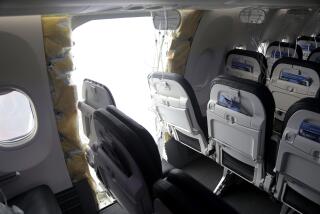NTSB says safety systems on Boeing’s 787 failed; probe ongoing
After investigating a fire that broke out on Boeing Co.’s 787 Dreamliner passenger jet, the National Transportation Safety Board said backup protections in the aircraft’s lithium ion batteries and electronics systems have failed.
Speaking to reporters Thursday from Washington, NTSB Chairwoman Deborah Hersman said the agency hasn’t reached a conclusion on the cause of the fire that occurred in Boston on Jan. 7. But she added that the redundant safety systems installed by Boeing did not work.
The announcement comes after the Federal Aviation Administration grounded the jet Jan. 16 after an emergency landing by All Nippon Airways due to a second apparent fire involving lithium ion batteries.
“These events should not happen,” Hersman said. “As far as design of the aircraft, there are multiple systems to protect against a battery event like this. Those systems did not work as intended.”
FULL COVERAGE: Boeing’s troubled Dreamliner
Hersman said the agency has “all hands on deck” looking into the problem, disassembling and scanning the battery from the Boston fire. So far, the investigators have found overheating was caused by short circuits and “thermal runaway,” a chain reaction in which heat spreads rapidly from cell to cell.
The NTSB does not know the exact cause of the fire, however, and is looking for possible contaminants or manufacturing defects. The agency is also working with officials from Boeing, FAA, the Navy and investigators in France and Japan.
Japan is where the second fire occurred and where Boeing’s lithium ion batteries are made by Kyoto-based GS Yuasa Corp.
“The significance of these events cannot be understated,” Hersman said. “These systems did not work and we need to understand why.”
Boeing has said it is working with its airline customers and the regulatory agencies to get the matter resolved, but it is a public relations nightmare for the Chicago company, which has long heralded the Dreamliner as a representation of 21st century air travel.
Problems are expected with any new plane, especially one as complicated and sophisticated as the 787, experts have said. But problems with new technology such as the lithium ion batteries may hold tougher challenges for Boeing.
The company has taken 848 orders for the 787 from airlines and aircraft leasing firms around the world. Depending on the version ordered, the price ranges from $206.8 million to $243.6 million per jet.
The 787, a twin-aisle aircraft that can seat 210 to 290 passengers, is the first large commercial jet with more than half its structure made of composite materials (carbon fibers meshed together with epoxy) rather than aluminum sheets. It’s also the first large commercial aircraft to involve pervasive use of electrically powered systems involving lithium-ion batteries.
ALSO:
United pulls preflight video touting Boeing Dreamliner
Dreamliner woes put spotlight on lithium ion battery risks
Boeing faces battles: fixing Dreamliner and winning back fliers







